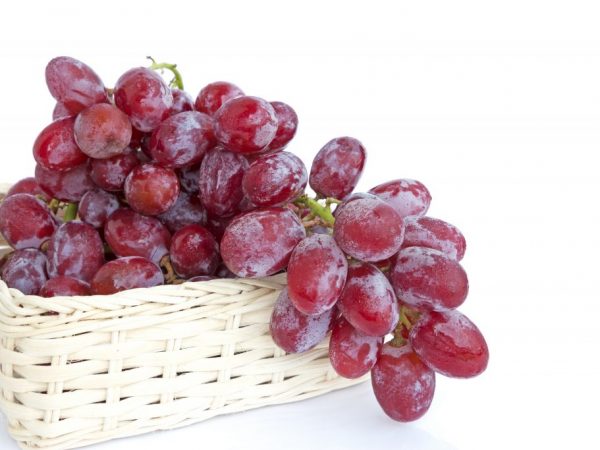Growing Rizamat grapes
The Rizamat grape is considered the most popular of all table crops. The only drawback is that this variety is too often exposed to fungal infections, so it must be well cared for.

Growing Rizamat grapes
Variety characteristics
The Rizamat grape variety is of German selection, which explains its large number of advantages. Vegetation lasts only 100 days, which makes the culture very early.
The description indicates that the white flowers are bisexual. This helps to enhance pollination and increase yields. It is believed that not all flowers pollinate each other. As a result, colorless berries appear on the bunches, which create a slight contrast.
External description
The bushes grow high, up to 5 m. The shoots are powerful, do not need to be pinched. The leaf plate is round in shape, with 5 lobes at the edges. The size of the sheet is average. The color is dark green. There are rough areas and small thin stripes on the surface. Pit for stalks of open type.
- medium-sized oval berries: weight 10-20 g, depending on growing conditions;
- the peel of the fruit is a delicate purple hue, slightly transparent;
- bunch weight 1 kg;
- the density of the peel is medium;
- high yield: from 1 ha to 150 kg.
According to the description of the variety, the Rizamat grape has tasty and sweet fruits. The composition contains a large dose of sugar. The first few years after the beginning of fruiting, acid is clearly heard in the taste. They make wines, desserts and dried fruits from it.
Growing rules

Plants need sunlight
Rizamat grape belongs to heat-loving crops, so it is better to plant it in lighted, not shaded areas, where the fruits will receive the right amount of sunlight. Choose areas on higher ground so that nearby groundwater does not interfere with the development of the bush. The minimum distance of groundwater from the surface of the earth should be 2-3 m. Often these grapes are planted near fences (at a distance of 3-4 m) so that they protect the plant from windy weather.
Optimal propagation with seedlings. It is better to buy it in specialized nurseries. Grafting on the seedling and a tag indicating the variety and care rules are considered mandatory conditions. The height of the bush should be 1 m, the length of the root system is 30 cm.
The planting process is simple. To begin with, in the fall, subject to spring planting, dig a hole (70x70 cm). A bucket of rubble and 3 kg of humus are poured onto the bottom. Such a drainage system not only protects the plant from excess soil moisture, but also nourishes the soil with useful microelements. On top of the drainage, soil is poured, up to 30 cm high. Inside such an embankment, a depression is made into which the seedling is placed.
The roots are distributed evenly, after which they are carefully sprinkled with earth. Since this grape variety is vigorous, there is a distance of 3 m between the bushes.Situations should not be allowed for other varieties to grow nearby, otherwise there is a risk of breeding a new hybrid, therefore, a distance of 7 m is kept between different varieties.
Culture care
Watering is carried out in the morning when there is no bright sun. For this, water at room temperature is used. Watering interval 15-20 days, depending on the climatic conditions of the region. After watering, begin to loosen the topsoil and remove weeds. This significantly increases the crop's resistance to pests and diseases.
Top dressing is especially important during the flowering period of the crop. At this moment, mineral fertilizers are applied to the soil in the form of potassium nitrate (20 g per 10 l of water). At the moment of the ovary of fruits and bunches, the bushes are fed with a superphosphate solution (50 g per 5 l of water). Pour 20 liters of the prepared preparation under each bush. In the fall, at the end of October, the soil is mulched with humus to protect the plant from frost.
Pruning is done in early spring. At this time, remove all damaged branches and dry vines. All antennae should be removed, and only 8 eyes should remain on the shoots.
Diseases and pests
The Rizamat grape variety has become more resistant to fungal infections, downy mildew (moniliosis) and coccomycosum. The only disease is black rot. Fighting her is pointless. If available, remove the entire bush and burn it away from the site.
According to the description, Rizamat is resistant to the invasion of aphids and beetles. Often affected by wasps or flea beetles.
- A solution of copper sulfate (30 g per 5 liters of water) will help to get rid of the wasp, which repels pests with its smell.
- In the fight against fleas, a manganese solution (5 g per 5 liters of water) helps. Spraying is carried out at intervals of 10 days, as in the fight against diseases.
Conclusion
Rizamat grape has a high yield to disease, gives tasty fruits, and it is also versatile in use.


